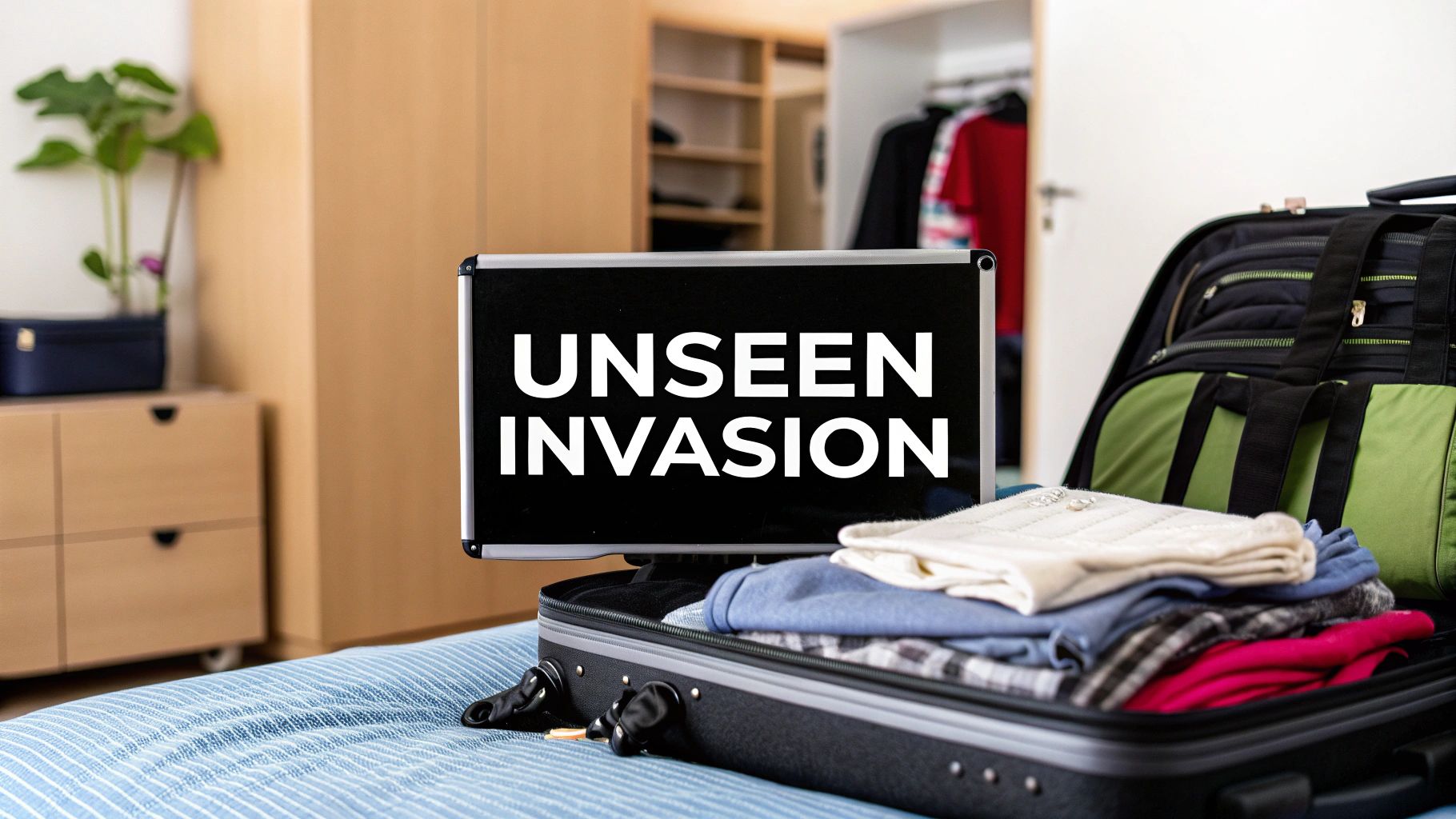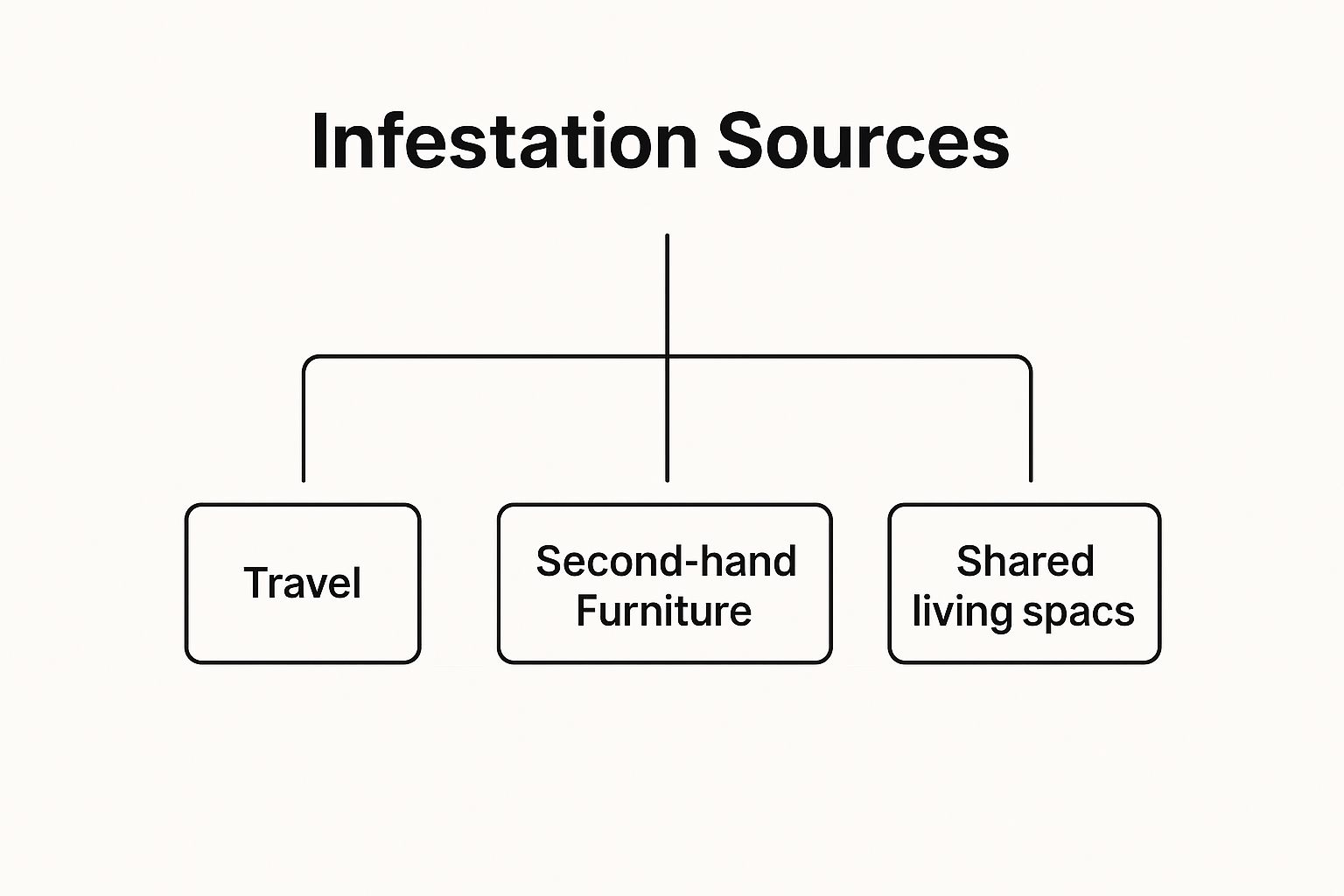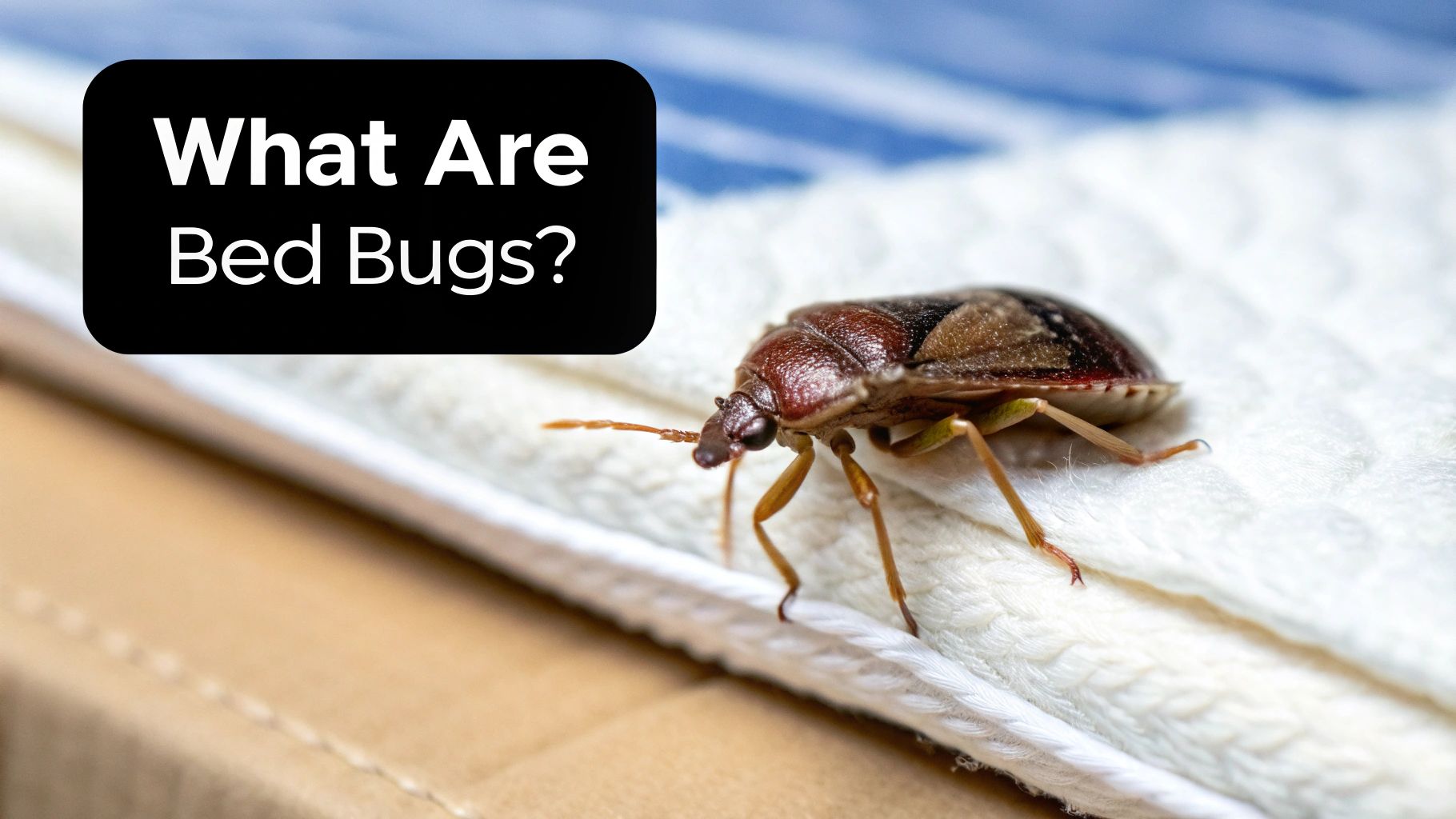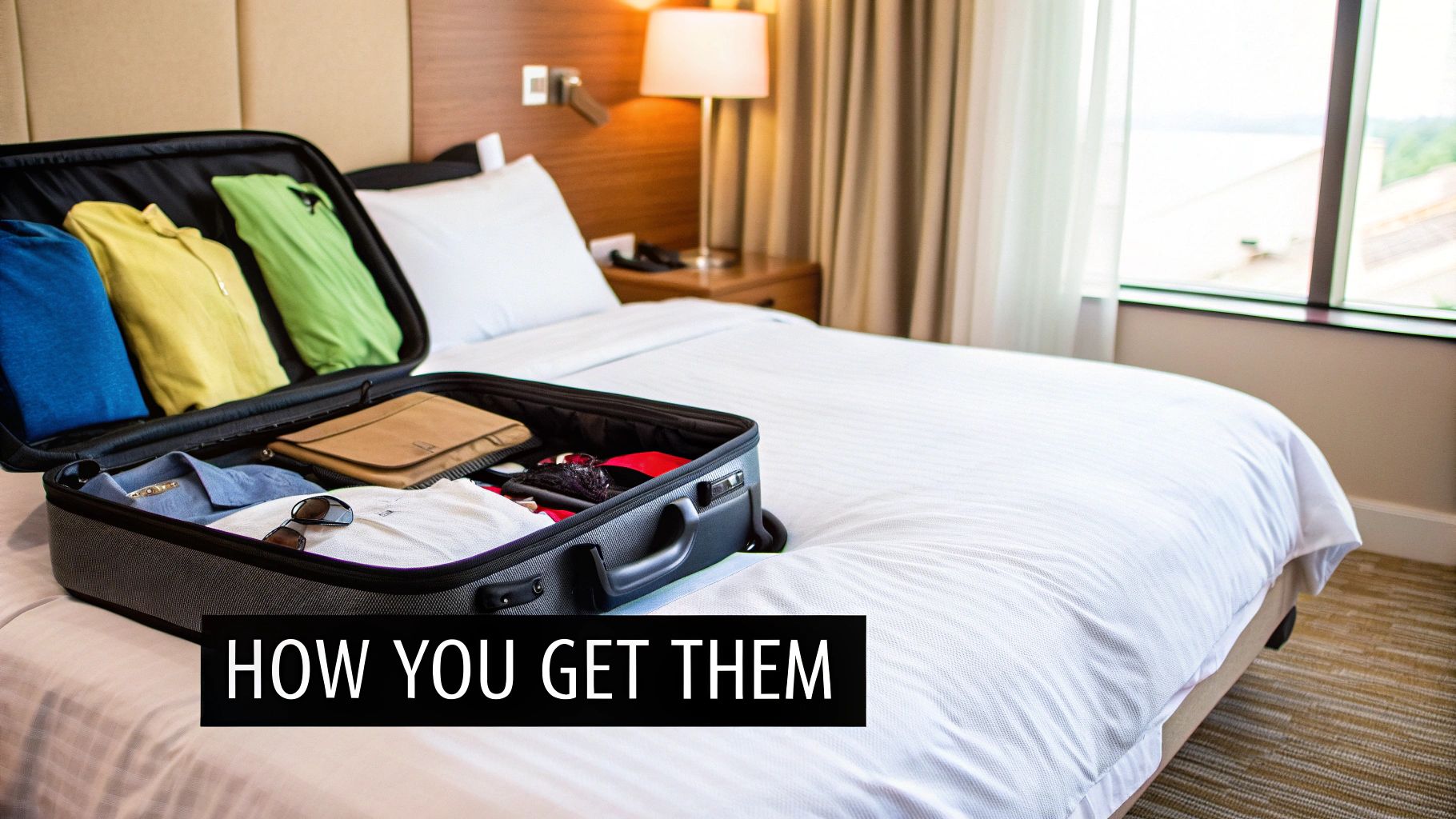
So, how do you get bed bugs? The short answer is that they are expert hitchhikers. You don't get them because your place is dirty; you get them because they've been transported from an infested spot to a new one by catching a ride on your belongings.
The Unseen Travelers: How Bed Bugs Invade Your Home
Think of bed bugs as tiny, unwanted stowaways. They can't fly or jump, but they are masters of crawling into hidden seams, cracks, and crevices. Once tucked away, they simply wait for a free ride.
This journey usually happens when they latch onto luggage, used furniture, or even the clothes you're wearing, moving from one location to another without anyone noticing. This is precisely why a five-star hotel room or a meticulously clean home can still end up with a bed bug problem. It has nothing to do with hygiene—it's all about accidental transport.
The biggest myth we see is that bed bugs are drawn to filth. The truth is, they only care about one thing: a blood meal. They will happily set up shop in any environment, clean or not, as long as a human host is nearby. Getting this straight is the first step to truly protecting yourself.
Primary Infestation Pathways
These pests are opportunistic travelers, and they use our own movements to spread far and wide. By far, the most common way you'll get bed bugs is by unknowingly bringing them home from an infested area.
The infographic below breaks down the three main sources we see in the field.

As you can see, your risk goes up significantly when you travel, buy secondhand items, or live in close quarters with others, like in an apartment building.
To keep yourself safe, you have to understand how they travel. Here’s a quick rundown of the most common ways people accidentally bring these pests into their homes.
Top Ways You Accidentally Bring Bed Bugs Home
This table summarizes the most common ways a few bugs can turn into a full-blown home infestation. It’s almost always a case of being in the wrong place at the wrong time and carrying an unseen passenger home with you.
| Transmission Method | Common Source Location | Primary Carrier |
|---|---|---|
| Travel & Lodging | Hotels, Motels, Hostels, Airbnbs | Luggage, Backpacks, Clothing |
| Secondhand Items | Thrift Stores, Yard Sales, Online Marketplaces | Upholstered Furniture, Mattresses, Bed Frames |
| Visitor & Neighbor Spread | Friends, Family, Adjacent Apartments | Personal Bags, Coats, Shared Wall Voids |
Understanding these pathways is key. Whether it's a suitcase from a trip, a cool vintage armchair, or a visitor's coat, the risk comes from items moving from an infested space into yours.
Travel And Lodging The Number One Risk Factor

If you're asking yourself, "How on earth did I get bed bugs?", the answer almost always comes back to travel. Think about it: hotels, motels, Airbnbs, and even buses are just revolving doors for people and their belongings. They're the Grand Central Station for these pests, making human movement the main way infestations spread across the globe.
Picture a single hotel room. It might host dozens of different travelers every single month. If just one of those guests unknowingly brings a few bed bugs in their suitcase, those bugs can quickly settle into the room's furniture, headboard, or outlets. Then you arrive. You place your suitcase on that luggage rack or on the floor, and just like that, the pests have found a new ride. They hitchhike on your stuff and follow you all the way home.
A lot of people think the price or star rating of a hotel will protect them. That’s a myth. Bed bugs show up in five-star resorts just as often as they do in budget motels because they couldn't care less about luxury. Their presence is all about exposure from a previous guest, not a reflection of how clean the place is.
Your First Five Minutes In The Room Are Crucial
The moment you walk into a hotel room is your single best chance to stop a potential infestation in its tracks. Before you even think about throwing your bags on the bed, take them straight to the bathroom. The tub or shower stall is your best bet. Bed bugs hate crawling on smooth, hard surfaces like porcelain and tile, so it's a relatively safe zone while you do a quick inspection.
Your mission is to check the most common hiding spots before you unpack and get comfortable. It's a simple habit, but it's hands-down your most powerful defense. If you want to understand just how important this is, learning about common travel mistakes from others' unfortunate experiences can really drive the point home.
"I learned the hard way the vital importance of always checking the sheets and seams of the mattress near the head of the bed for the tell-tale black spotting and little shiny bumps that indicate an infestation."
This isn't just one person's story; it's the same advice you'll get from experts and even government agencies. Being vigilant is everything.
Use The S.L.E.E.P. Method For A Thorough Check
The U.S. Environmental Protection Agency (EPA) came up with a handy acronym to help travelers remember what to do. Following the S.L.E.E.P. method can seriously cut your risk of bringing home unwanted guests.
- Survey the room for any signs of an infestation. You're looking for tiny, rust-colored spots on the bedding, mattress, or nearby furniture.
- Lift and Look in all the typical hiding spots. This means checking the mattress seams, the box spring, and behind the headboard. Your phone's flashlight is your best friend here.
- Elevate your luggage. Keep it away from the walls and definitely off the floor. That metal luggage rack is a good option, but give it a quick once-over first.
- Examine your luggage carefully when you're packing up to leave and again as soon as you get home.
- Place all your washable clothes directly into the dryer on high heat for at least 30 minutes the moment you walk in your door.
This risk is very real. Pest control professionals saw calls for bed bugs jump by 35% between 2022 and 2024, a spike tied directly to the return of global travel. It just goes to show how critical awareness has become. A few minutes of prevention can save you from months of headache and a whole lot of expense.
Secondhand Treasures And Their Hidden Dangers
Everyone loves a bargain. But that amazing find at the thrift store or from an online seller can bring a nasty, unwelcome surprise right into your home. While many people get bed bugs from traveling, one of the most common ways they invade is by hitching a ride on used items.
These pests are pros at hiding, and secondhand goods give them the perfect cover to sneak past your defenses.
Think about it. You find a gorgeous vintage armchair that’s just perfect for your reading nook. It looks clean, feels solid, and you get it for a steal. What you don't see are the nearly invisible eggs or a few dormant adults tucked away deep inside a seam or a wooden joint. That beautiful chair suddenly becomes a "Trojan Horse," silently unleashing a full-blown infestation weeks after you’ve brought it inside.
The Highest-Risk Items To Watch Out For
You can find a stray bed bug on just about anything, but some items are far riskier than others. You need to be extra careful with certain types of secondhand goods.
These pieces offer the dark, quiet hiding places that bed bugs dream of:
- Upholstered Furniture: Sofas, love seats, ottomans, and armchairs are bed bug paradise. They are loaded with seams, tufts, and deep, dark voids.
- Mattresses and Box Springs: Honestly, just don't do it. Never, ever bring a used mattress or box spring into your home. The risk is just too high, as this is their absolute favorite place to nest.
- Wooden Furniture (Especially Bed Frames): Bed frames, nightstands, and dressers need a close look. Bed bugs love to hide in the joints, screw holes, and tiny cracks in the wood.
Your Pre-Purchase Inspection Checklist
Before you even pull out your wallet, you need to channel your inner detective. A really thorough inspection, right there on the spot, can save you a world of trouble later. Grab your phone and turn on the flashlight for a good, clear view.
Here are the classic tell-tale signs you're hunting for:
- Live Bugs: Check every single crack, crevice, and seam for small, reddish-brown insects about the size and shape of an apple seed.
- Dark Spots: Look for small, dark stains that look like someone touched the fabric with a black marker. This is actually bed bug fecal matter.
- Shed Skins: As young bed bugs grow, they molt and leave their old skins behind. These look like yellowish, see-through, hollow versions of the bug itself.
- Eggs: The eggs are incredibly small—about 1 mm long—and look like tiny, white or pearly grains of rice. They’re usually laid in tight clusters in hidden areas.
Remember: Don't just look for live bugs. Seeing no live insects does not mean the item is safe. The dark fecal spots and shed skins are often the most obvious signs of a problem, past or present.
If you spot any of these signs, put the item down and walk away. It is absolutely not worth the risk.
Even if an item passes your visual inspection, you should still treat it as contaminated before it comes into your house. For clothing or textiles, seal them in a plastic bag, then immediately put them in a dryer on high heat for at least 30-40 minutes. For furniture, your safest bet is a thorough steam cleaning or getting it professionally treated before it ever crosses your threshold.
Surprising Bed Bug Hotspots In Everyday Places

When you ask, "how do you even get bed bugs?", your mind probably flashes to seedy hotel rooms or a questionable second-hand couch. And while you're not wrong about those, the truth is that these pests have branched out. They are masters of survival, now popping up in all sorts of public places we visit every day.
Think of public spaces as bed bug transit hubs. A single bug can crawl off a shared seat and onto your jacket, or drop from a piece of furniture into your open backpack without you ever knowing. One brief stop at an infested location is all it takes to unknowingly pick up a stowaway and bring the problem home.
The reality is, we've seen a massive global comeback of bed bugs since the 1980s. They're showing up in schools, hospitals, and even on our daily commute. This resurgence has been fueled by things like increased international travel and warmer global temperatures, which can actually make the bed bug life cycle speed up. You can learn more about the global spread of these pests to get the full picture.
Your Daily Commute And Entertainment
It’s a bit unsettling to realize just how many opportunities bed bugs have to find you during your normal routine. Any high-traffic spot with lots of seating is a prime location for a bed bug to hitch a new ride.
Here are a few common hotspots you might not have considered:
- Public Transportation: The fabric seats on buses, trains, and even in rideshares are full of dark, hidden crevices—perfect hiding spots. As people get on and off, a bug has plenty of chances to move from the seat to a passenger's bag or clothing.
- Movie Theaters: Think about it: plush seats, a dark environment, and a steady stream of people sitting still for hours. It’s a bed bug’s dream. A bug can easily transfer from the theater chair to your coat while you’re lost in the movie.
- Libraries and Waiting Rooms: Those shared chairs in libraries, doctor's offices, or the DMV? They're also potential transfer points. People often place their bags and coats on or right next to these chairs, giving pests a golden opportunity to climb aboard.
The main thing to remember is that anywhere people gather and stay in one place for a while can become a transfer zone. The bugs aren't living permanently on the bus; they're just using it as a bridge to get from one person's home to another.
Workplaces And Offices
Even your office isn't a guaranteed safe zone. An infestation at work can start with just one person unknowingly bringing bed bugs from their home on a backpack, laptop case, or coat.
Once inside the office, these pests can make themselves at home in upholstered office chairs, beneath desks, or inside the fabric of cubicle walls. From there, it's a short crawl to another employee's belongings, and just like that, they're on their way to a new house. This is how one person's problem can quickly spread throughout an entire office.
To lower your risk, try to keep your personal items like purses and backpacks off the floor. It’s always better to hang your coat on a hook rather than tossing it on a shared sofa or chair. A little bit of vigilance in these unexpected hotspots can make all the difference in preventing a major infestation at home.
When Visitors Arrive And How Neighbors Share Pests

Sometimes, the source of a bed bug problem is uncomfortably close to home. It’s not always a budget motel or a piece of second-hand furniture. The real culprits can be as close as the apartment next door or even a friend who just stopped by for a visit.
Living in multi-unit buildings like apartments, condos, or townhouses creates a unique and often overlooked risk. Think of these buildings as a massive, interconnected network. Bed bugs are incredibly small and flat, which allows them to travel with surprising ease from one unit to another through all the hidden nooks and crannies.
They can slip through tiny cracks in the walls, follow plumbing lines, or even crawl along electrical wiring inside the walls. An infestation in your neighbor’s apartment can quickly become your problem, no matter how careful you've been.
When Guests Unknowingly Bring Pests
This is always a tricky subject. No one likes to imagine that a friend or family member could be the source of a pest infestation. The reality, though, is that it happens all the time. A visitor who has a small, undetected issue at their own home can easily bring a few bugs over on their coat, in a purse, or inside an overnight bag.
It’s important to remember this doesn't make them bad guests; it just underscores how easily these pests can hitch a ride. The key is to be prepared without turning your home into a fortress or making social gatherings awkward. You don't need to cross-examine your friends, but you can take a few quiet, simple steps to protect your space.
Here’s how you can handle visitors without causing a scene:
- Create a Designated Drop Zone: When guests arrive, gently suggest they leave their bags and coats near the entrance. A hard surface like tile or hardwood flooring is best, well away from any bedrooms or upholstered furniture.
- Wash Linens Immediately: As soon as your overnight guests head home, strip the bed. Wash all the linens, blankets, and even towels in hot water, then dry them for at least 30 minutes on the highest heat setting.
- Do a Quick Inspection: After they're gone, take a moment to do a quick visual check of the furniture where they were sitting and the spot where their bags were kept.
The goal here is proactive prevention, not finger-pointing. Think of it as a standard part of your hosting routine, just like cleaning the bathroom or putting out fresh towels. It’s a discreet habit that can give you incredible peace of mind.
Understanding these less obvious entry points is a critical piece of a solid defense strategy. To get a better sense of our expertise and mission, you can learn more about the experts behind our advice by checking out our About Us page. Protecting your home means being aware of every potential risk, both from far away and right next door.
The True Cost Of A Bed Bug Infestation
Knowing how you get bed bugs is one thing. Truly understanding what an infestation will cost you—in money, time, and sanity—is another entirely. The financial hit alone is often what convinces people to get serious about prevention.
From the moment you find that first bug, the meter starts running. This isn't a pest problem you can solve with a can of store-bought spray; professional extermination is almost always required. Depending on how bad the infestation is and the size of your space, you could be looking at a bill ranging from a few hundred to several thousand dollars.
The Financial Fallout
On top of the professional treatment costs, the collateral damage adds up fast. You’ll likely have to part with infested items that are just too risky or difficult to salvage.
- Mattresses and Box Springs: These are ground zero for an infestation and often the first things that have to go. Replacing them is a serious expense.
- Furniture: Sofas, upholstered chairs, and even wooden items like nightstands or bed frames can harbor bugs and may need to be thrown out.
- Clothing and Linens: While you can save a lot with high-heat washing and drying cycles, delicate items that can't take the heat might be a total loss.
This financial drain is fueling a massive global bed bug control market, which is projected to climb to USD 2.04 billion by 2033. This number isn't just a statistic; it represents countless homeowners and renters forced to pay up. You can learn more about the rising bed bug control industry and see just how widespread this problem has become.
More Than Just Money
As bad as the financial cost is, the emotional toll is often much, much worse. Living with bed bugs means living in a constant state of anxiety and stress.
The psychological impact is profound. Victims often report feeling constantly on edge, unable to relax even in their own homes. This can lead to severe insomnia, as the fear of being bitten makes sleep nearly impossible.
That anxiety rarely stays within your four walls. It’s common to feel a deep sense of shame and social stigma, causing people to pull away from friends and family out of fear they might spread the bugs. The feeling of being "unclean" is powerful and damaging, even though infestations have absolutely nothing to do with personal hygiene.
Ultimately, preventing an infestation isn’t just about avoiding an inconvenience. It's a critical investment in protecting your finances and, just as importantly, your peace of mind.
Frequently Asked Questions About Bed Bugs
Even with a good grasp of the risks, it's normal to have a few more questions rattling around in your head. Let's clear up some of the most common myths and misunderstandings about how you get bed bugs.
Can Bed Bugs Jump or Fly to a Person?
No, they can't. Bed bugs don't have wings to fly, and their legs aren't built for jumping. They are crawlers, plain and simple.
This is a really important detail. It means they need to hitch a ride on something to travel long distances. Think luggage, backpacks, clothing, and even used furniture. They aren't going to leap onto you as you walk by an infested room; they need to crawl onto an object you're carrying to make their move.
Are Bed Bugs a Sign of a Dirty House?
This is the biggest myth out there, and it's a harmful one. Let's be perfectly clear: absolutely not. Bed bugs couldn't care less about dust, clutter, or grime. They are drawn to three things: the warmth of our bodies, the blood they need to survive, and the carbon dioxide we breathe out.
A spotless five-star hotel can get an infestation just as easily as any other home if a traveler brings them in unknowingly. Cleanliness doesn't prevent them, only being vigilant and aware does.
Can I Get Bed Bugs Directly From Another Person?
It's extremely unlikely. Unlike pests like lice, bed bugs do not live on our bodies or in our hair. They are incredibly secretive and spend their time hiding in dark, out-of-the-way places near where people sleep or rest.
They wait for you to be still, usually while you're asleep. Transmission happens when a bug crawls from its hiding spot onto a belonging—like a coat draped over a chair or a purse set on the floor—which is then taken to a new home. That’s how a new infestation begins.
For more answers to your pressing questions, check out our other bed bug FAQs.
For verified scent detection canine owners, research facilities, and Pest Control Professionals in need of live specimens, Buy Bed Bugs Online provides healthy, living bed bugs for training and testing purposes. We supply both our robust field strain and the Harlan strain for specialized research. Visit us at https://buybedbugsonline.com to support your professional needs.
